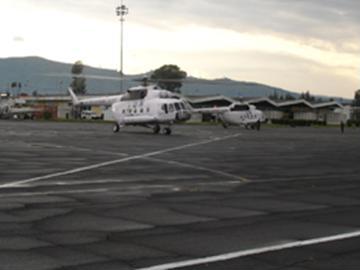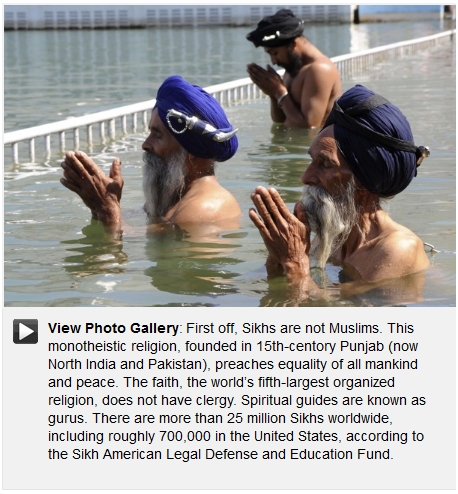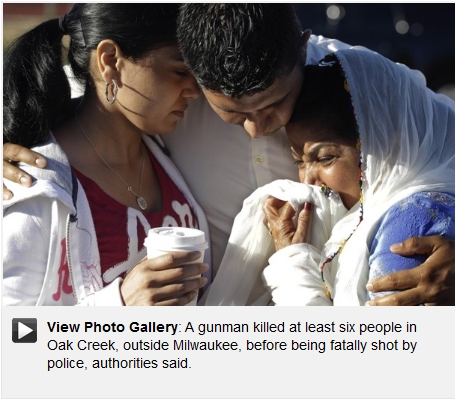One day after Wade Michael Page opened fire and killed six Sikh Americans at a Milwaukee temple, the head of the U.S. Air Force Academy confused Sikhs with Muslims during a briefing before students and staff.
Lt. Gen. Michael Gould is superintendent of the Colorado Springs military school. His job is to help educate, train and inspire the 4,000 young men and women at the academy to become “officers of character,” according to the school’s mission statement. Yet this highly decorated, well-educated military leader referred to the Sunday morning massacre as taking place at a “Sikh mosque,” as reported by the Colorado Springs Independent. Later, an academy public information officer compounded the error by mixing up Sikhs with Hindus.
While it would be easy to dismiss both mistakes as simple gaffes, I believe that if you pull the thread, you’ll unravel the long history of ignorance about and discrimination against Sikh Americans – and our struggle to be seen and treated as Americans.
I began chronicling the Sikh American experience immediately after Sept. 11, 2001. Sharat Raju and I produced the documentary “Divided We Fall,” the first feature film on hate crimes against Sikh Americans. As we traveled the country in a time when turbaned Sikh Americans became lightning rods for anti-Muslim violence, I heard many comments like Gould’s.
More than a decade later, most Americans still don’t know anything about Sikh Americans. Many do not know that Sikhs are victims of hate crimes, profiled at airports, bullied in schools, and denied the ability to practice their faith in workplaces.
 |
| Indian Air Force, part of a U. N. peacekeeping mission to the Democratic Republic of Congo (DRC) |
In order to understand why the turban means so much to Sikh Americans today, we need to understand its political, religious, and historical context. In 15th century Punjab (now northern India and Pakistan), during a time of religious strife, the founder of the Sikh tradition Guru Nanak expressed a unique vision of unity, rejecting all social inequalities, including caste hierarchies, gender discrimination, and religious persecution. He called for devotion to the One Divine, justice and equality of all people, and a commitment to seva or divinely-inspired service. Sikhs wear the turban, traditionally a symbol of royalty in the South Asian context, as crowns that represent their commitment to be saint-soldiers: to stand up and fight injustice in all forms.
The U.S. military’s policy barring Sikh Americans from serving their country is not set in stone: there have been significant exemptions, suggesting that the discriminatory policy can be overturned.
In December 2011, Maj. Kamaljeet Singh Kalsi was awarded a Bronze Star for his exceptional life-saving efforts as an emergency physician while serving in Afghanistan and wearing his turban and beard. He is the first turbaned Sikh to serve in the U.S. Army in almost 30 years. The Army had granted Kalsi and two other Sikh soldiers individual accommodations allowing them to honor their religion.
Last week, I attended a conference at the White House with Kalsi to speak about the future of Sikh and South Asian Americans in this country. There, just 48 hours before the Milwaukee shooting, we discussed the long struggle to break barriers in this country, including the call to end the general policy of Sikh exclusion from U.S. military service.
Afterward, I spoke with his younger brother Ranjeet Kalsi, a 22-year old medical student with a dream to become a doctor in the Air Force. He said he was recently denied admittance by Air Force recruiters because of his turban, but he’s not going to give up.
“Both my father and grandfather were in the Indian Air Force,” said Ranjeet Kalsi. “Being in the military is a celebrated part of my heritage as both a Sikh and a Kalsi.”
History books have commemorated more than 300 years of the Sikh military tradition, including service in both World Wars. Growing up, I heard stories of my grandfather and great-grandfather who served in the British Indian army as part of a long-standing tradition of service to country in India, Canada, Great Britain and Europe.
My other grandfather, my father’s father, was a Sikh pioneer who sailed from Punjab, India, to settle in California a century ago. It took him decades to earn the right to vote, to own land and to become a citizen. His struggle is the story of all people to become fully equal Americans, from the suffrage movement to the Civil Rights Movement.
Incredibly, it took until 1975 for women to enter U.S. service academies such as the Air Force Academy. And while there are still prohibitions against women serving in combat, women are now expected to make up a quarter of the military by 2025. We have made progress.
But with Sikh American children bullied in school, Sunday morning worshippers caught in gunfire, and hate groups like Page’s on an alarming rise, it’s clear we still have a long way to go in this country to build a free and equal society for the next generation.
As a young Sikh medical student, Ranjeet Kalsi is disappointed by Gould’s comment, but he doesn’t blame him. He understands that education about Sikhs in America is virtually non-existent and believes the military is an institution that can help change that.
“The United States military is one of the most respected institutions in the world,” said Ranjeet Kalsi. “If they accept Sikhs, why wouldn’t anyone else?”
If we want a world where every person is treated with human dignity, the U.S. military, for one, must fully embrace what they profess to teach: respect for religious diversity. The Air Force Academy’s Gould is to be credited for his recent efforts to encourage his cadets to respect all religious beliefs – or non-beliefs. But those efforts came about only after an academy survey showed some non-Christian cadets were subjected to unwanted religious proselytizing at the school.
We can preach pluralism and respect but unless the U.S. opens doors to minorities in every U.S. institution, little will change. Many Sikhs are lining up to join the military, to serve their country. On their behalf, we can join the Sikh Coalition to call for the end to the exclusion policy.
It was President Harry Truman who ordered the desegregation of the Armed Forces, requiring “equality of treatment and opportunity for all persons in the armed services without regard to race, color, religion or national origin.”
Truman signed that order in 1948. How much longer must we wait?
----------------------------
Valarie Kaur, an award-winning filmmaker, legal advocate, and interfaith organizer, is founding director of Groundswell, an initiative at Auburn Seminary that combines storytelling and advocacy to mobilize faith communities in social action. Kaur studied religion and law at Stanford University, Harvard Divinity School, and Yale Law School, where she now directs the Yale Visual Law Project. Her documentary “Divided We Fall” is the first feature film on hate crimes against Sikh Americans after 9/11. You can follow her on Twitter at @valariekaur.
Send a message of support to the Sikh families in Milwaukee and attend a vigil in your community at Groundwell’s Web site.







